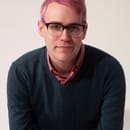Have you ever read a book that almost feels as though it appeared to you for a reason? I can only imagine you have and I hope it’s brought you immense joy. When I saw a copy of Witches, Sluts, Feminists: Conjuring the Sex Positive by Kirsten J. Sollée, I was drawn to its cover. Black and yellow, with the title in large letters surrounding a pair of black, glossy, and glittery lips slightly pursed, I was compelled to pick it up. Upon reading its description, I knew I needed a book like this in my personal library. Folks, I’m sure glad I bought it.
Reminiscent of theory books like bell hooks’s Feminism is for Everybody, Solée’s book serves as a primer concerning witchcraft and the ways it interacts with feminism and sexuality. The main aim of this conversation is to connect the history of witches as we have seen them with the more modern signifier of “slut.” While it may seem strange to try and relate “slut” and “witch,” it’s a far easier task than you’d expect. Our history and present are steeped in damaging patriarchal values and assumptions about women and their autonomy and reproductive rights.
Solée is a writer and teacher at The New School in New York City, where she focuses on gender studies courses surrounding this very topic. She is a founding “editrix” at Slutist.com, a site that focuses on sex positivity, feminism, and healthy witchcraft practices. The website is discussed further in the book, highlighting its work toward reclaiming the body politic of “slut” and utilizing this word to foster positive narratives about safe sex and exploration. One of the key points in Witches, Sluts, Feminists is that sexuality and occultism go hand in hand. Much of the fear men had of witches was due to the “mysteriousness” of women’s sexuality and the deeper connections with their own bodies that came through worshipping Nature. Fun fact: there was a genderless term for practicing witches, “wicche,” that came from Middle English. This would eventually morph into the universal “witch.”
Feminism plays a huge part in this book. Right off the bat, Solée cites hooks’s incredible and concise definition: “a movement to end sexism, sexist exploitation, and oppression.” What I truly gushed about was then the author went on to discuss hooks’ decision to not gender the concept of oppression. Oppression exists for both genders, though in differing ways. Despite the supposed gains that men should receive from patriarchy, “gender stereotypes and sexist narratives” can be just as damaging for them as their sisters. It was so incredible to see that Solée and I shared the same views on hooks’ landmark theories. To understand the sexual and emotional violence that is acted upon women in this society, we need to look at the misinformation and emotional violence enacted upon boys and men.
These ideas are explored through the actions and beliefs of religious figures during the Salem witch trials, Heinrich Kramer’s scandalous troll-tome The Malleus Maleficarum, and even our Commander in Chief during the last election. In a chapter discussing reproductive rights, Solée tells of the early anti-abortion efforts of “the American Medical Association to discredit midwives and establish the primacy of ‘real’ (male) doctors.” Many midwives and healers were executed during the witch trials, not so much for “the type of healing being practice by the wise woman…but the fact that she was an unlicensed healer,” as Hillary Bourdillon is cited in the chapter. They were made to blame when wounds would not heal, or diseases went uncured. Many of the doctors on call during the witch trials were explicitly male. This stigma remains in our society today. While many women hold high positions in the medical world, the majority of doctors remain male who “remain willfully ignorant of biological facts regarding sexual and reproductive health.” Amen.
Another aspect of the book that I truly love is its feeling of inclusion. Solée does not only rely on theory or text-based research to further her ideas; several sections feature interviews with a wide range of individuals such as scholars, artists, and all manner of practicing witches of varying races, genders, religious practices, and sexualities to create a brilliant cornucopia of experiences. In an interview with Hazlitt, Solée asserts her want to make this book as intersectional as feminism should be: “I am a white woman—but there were so many witches, feminists, and theorists of color that were extremely important to me and my continued growth as a feminist, so how could they not be part of the story? Within the history of witches and witchcraft, you cannot separate them.” I cannot agree more.
Intersectionality is becoming more prevalent within the feminist movement thanks to Kimberlé W. Crenshaw’s introduction of the term in the early 90’s and powerful TED Talk in 2016. Solée is aware of the extent of her experiences, but does not allow that to limit her research. She uses this book to amplify the voices of those consistently marginalized in our history. She even discusses prominent female historical figures such as Elizabeth Cady Stanton, Sojourner Truth, and Victoria Woodhull who were central to the women’s movement, revealing their connections to Spiritualism and other practices. She looks at pop culture and figures such as the member of The Satanic Temple, Jex Blackmore and the artist Rebecca Goyette for their acts of rebellion against patriarchal views of the witch and the autonomy of their bodies.
This book is so important. Contextualizing rape culture through the lens of witchcraft and its history is bold but also necessary. Women deemed as witches were accused by husbands, sons, and even fellow women, as a means to control their autonomy. As a culture, we often use the word “slut” to do harm. It seeks to control women’s bodies and strip them of their sexual autonomy. Our culture uses “slut” in this fashion far too liberally than we should. I am shameful for the times I used it in foolish ignorance, believing sexuality was something that women should mediate on men’s behalf. I had none of the knowledge that I currently possess concerning the complexities of sexuality, and this book helped me to further understand the ways oppression, toxic masculinity, and rape culture harm and have harmed our sexual politics. It also worked as a “gateway drug”—as Solée cheekily describes her book in the introduction—sparking my interest in witchcraft while making me want to further explore the ways it connects to feminism and oppression. While I can’t describe everything that makes this book fantastic, I implore you to give it a read. It’s the beginning of some massively important work, and I look forward to reading more of her writing in the coming years.
You can follow Kristen on Twitter: @ShadowtimeNYC


